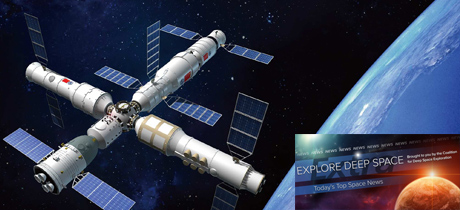In Today’s Deep Space Extra… NASA and Boeing progress toward July launch of Starliner. China marks first crewed mission to its new space station.
Human Space Exploration
NASA and Boeing close out recommendations from Starliner review
Coalition Members in the News – Boeing, United Launch Alliance
SpaceNews.com (6/17): Boeing’s Starliner spacecraft is currently undergoing fueling in preparation for launch of Orbital Flight Test-2 (OFT-2), planned for July 30. The company and NASA announced yesterday that they had closed all the actions from an independent review in 2020 to address problems with the first Orbital Flight Test (OFT) mission of the spacecraft. If OFT-2 launches on schedule and is successful, NASA will consider flying the first crewed flight of Starliner this year. The next step for the spacecraft before launching on OFT-2 is to be mated with ULA’s Atlas V rocket, which will launch it to the International Space Station (ISS).
China, Russia lay out joint plans to explore the moon while China launches first crew to Tianhe
SpacePolicyOnline.com (6/16): Russia and China revealed their roadmap for joint exploration of the Moon at the Global Space Exploration (GLEX) conference in St. Petersburg, Russia on Wednesday. The endeavor would take place over three phases. The first, through 2025, involves precision soft lunar landings of unpiloted spacecraft equipped for reconnaissance. The two-stage second phase, 2026 to 2030 and 2031 to 2035, includes sample return, technology testing, and cargo deliveries. Astronaut activities would follow in the third phase, after 2036. At the same time, three astronauts aboard China’s Shenzhou-12 spacecraft launched to the country’s space station Tiangong, docking with the Tianhe module. Their planned three-month stay will include spacewalks as assembly of the new station continues.
Spacewalkers run out of time before unrolling new Space Station solar array
Spaceflightnow.com (6/16): Spacewalking astronauts Shane Kimbrough, of NASA, and Thomas Pesquet, of the European Space Agency (ESA), encountered difficulties on Wednesday as they attempted to install the first of six Roll Out Solar Arrays (ROSA) to boost and extend solar power generation aboard the International Space Station (ISS). Kimbrough overcame a space suit issue, but efforts to secure the structure holding up the new rolled up array to the ISS’s solar power truss in order to unfurl encountered structural obstructions. Ground based experts will assess the issue and determine whether a second spacewalk planned for Sunday can proceed to address the issue or proceed with installation of a second ROSA. Further spacewalk activity could be postponed.
Space Science
Hubble just shut down and is fighting for its survival
Interestingengineering.com (6/16): The Hubble Space Telescope, now 31, experienced a difficulty with an on-board computer that placed the orbiting observatory in safe mode, NASA reported on Wednesday. The incident unfolded on Sunday afternoon. A degrading memory module may be to blame. Ground based experts planned to switch to a backup computer and spend time assessing its response, hopeful that science observations can be restored.
Other News
A House committee chair has ambitious plans for revamping the FAA’s role in space
POLITICO Space (6/17): Yesterday, the House Transportation and Infrastructure Committee’s Aviation Subcommittee held a hearing on the FAA’s role in regulating commercial spaceflight. Members of Congress asked about the FAA’s dual mandate of ensuring and promoting aviation and spaceflight. Members also expressed concern about the current moratorium for developing regulations regarding spaceflight of private astronauts as space tourism grows. Another concern was the integration of growing commercial launch activities into the national airspace system. Wayne Monteith, Associate Administrator for Commercial Space Transportation at the FAA said the Space Data Integrator program will run a demonstration in the near future and that the program is intended to minimize disruptions caused by commercial space activity. Tory Bruno, CEO and President of United Launch Alliance (ULA) expressed concern about megaconstellations and the density of certain orbits in space. Regarding the FAA’s performance-based regulations, Bruno said it’s a good way to incentivize innovation while maintaining safety, stressing that loss of life or harm to property from launch incidents can hurt the industry and the country.
ESA and EU to sign partnership agreement
SpaceNews.com (6/16): The chair of the European Space Agency (ESA) council announced Wednesday that it will sign an agreement with the European Union (EU) that will allow ESA members who are not part of the EU, including Norway, Switzerland, and the United Kingdom to participate in at least some EU space programs. ESA has been in discussions about becoming a possible partner with China and Russia in the development of an International Lunar Research Station (ILRS) at the Moon. ESA is a partner in the NASA-led Artemis initiative to establish a permanent human presence at the Moon to prepare for future expeditions to Mars. The EU plans a June 22 event in Brussels to launch its space program and provide more details.

